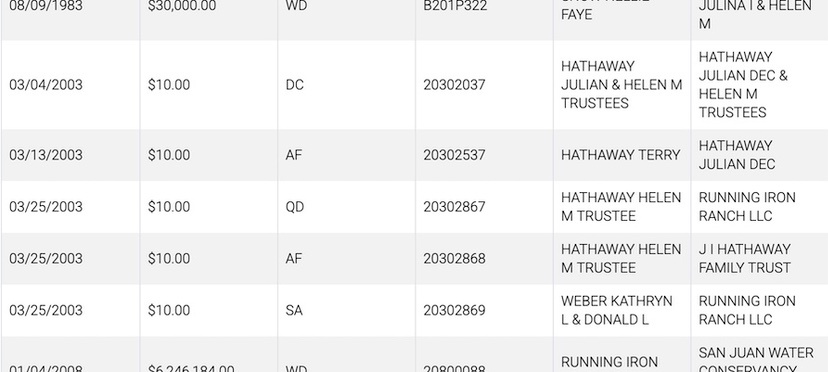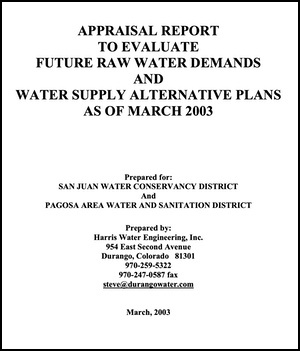As I noted in Part Two of this editorial series, we might be tempted, at the end of a lawsuit, we might be tempted to point to a “winner” and a “loser”. In the case of a lawsuit involving two government entities, one or the other might claim victory at the end of the often-lengthy process, but the taxpayers who ultimately foot the legal expenses could see themselves as the losers, no matter which way the judicial review turns out.
This could be the case with the current legal wrangling between San Juan Water Conservancy District (SJWCD) and Pagosa Area Water and Sanitation District (PAWSD). The taxpayers could wind up the ultimate losers.
Disclosure: I currently serve as a volunteer member of the PAWSD Board of Directors, but this editorial reflects only my own opinions, and not necessarily the opinions of the PAWSD Board and staff.
In Part Two, I mentioned that PAWSD and SJWCD, working as a team, got themselves sideways with a private landowner during the 1990s, and — in spite of spending plenty of money on attorney fees — lost access to what could have been a valuable municipal reservoir in Hidden Valley.
We also noted that PAWSD and SJWCD, working as a team, also spent plenty of money on lawyers in 2007, and then again in 2009, trying to defend an water right decree for a 35,000 acre-foot reservoir in the Dry Gulch Valley. That decree was rejected — twice — by the Colorado Supreme Court. The PAWSD and SJWCD lawyers then settled, behind closed doors, with legal challenger Trout Unlimited, agreeing on a smaller water right that added additional protections for the San Juan River.
Not an inexpensive process.
Another part of reservoir planning that’s not inexpensive — for the taxpayers — is engineering.
In March 2003, noted water engineer Steve Harris delivered a report to PAWSD and SJWCD (which you can download here) claiming that the best location for a future Archuleta County reservoir was in the Dry Gulch Valley, on what is now the Running Iron Ranch. The site had certain disadvantages (especially when compared to Hidden Valley) but engineer Harris demonstrated — with carefully calculated numbers — that the Dry Gulch Reservoir was not only feasible, but was in fact absolutely necessary to the primary industry in Archuleta County: real estate development.
As mentioned, this report was officially delivered in March 2003. We can guess that the real estate value of the Running Iron Ranch may have been affected by the report.
That same month, March 2003, the ownership of the Running Iron Ranch changed hands in a flurry of seemingly innocent real estate transactions.
From the Archuleta County Assessor’s website:

PAWSD and SJWCD, working as a team, purchased the Running Iron Ranch from the Weber family, in 2008… while the two districts were still fighting in court with Trout Unlimited. The Archuleta Board of County Commissioners provided a special variance to the normal (and legal) subdivision process, to allow the sale to proceed.
The PAWSD customers subsequently elected new members to the PAWSD Board of Directors who did not support the Dry Gulch Reservoir project.
It’s now 2025. PAWSD and SJWCD are still joint owners of the Running Iron Ranch.
PAWSD recently received unsolicited offers from private parties, offering to purchase the Running Iron Ranch for a price that would save PAWSD customers more than $10 million in future loan payments. The PAWSD Board has voted unanimously to sell the Ranch, under a 2016 PAWSD-SJWCD agreement that states, in part:
4.2.2. The PAWSD may decide to abandon the [Dry Gulch] Project and sell the Running Iron Ranch pursuant to the terms of Paragraph 5 below…
5.2.1. PAWSD agrees to make every effort to retain the Running Iron Ranch during the Planning Period made possible by this Agreement. In the event that PAWSD, in its sole discretion but after consultation with SJWCD and CWCB, does sell the Running Iron Ranch during the Planning Period, the following terms shall take effect…
SJWCD does not pay anything at all on the Dry Gulch loan payments. The financial responsibility falls totally on PAWSD customers.
SJWCD has claimed that PAWSD does not, in fact, have the right to sell the Ranch during the “Planning Period”…
…even though the agreement specifically spells out the terms under which PAWSD may sell the Ranch “during the Planning Period”.
Two water districts, once partners, with different opinions about their own legal powers.
Who will be the winner, and who will be the loser? One could easily claim that the taxpayers will be the losers.
As mentioned in the disclosure above, I serve on the PAWSD Board of Directors, and I voted to offer the Running Iron Ranch for sale. I also voted to have our PAWSD attorneys ask a judge to review the 2016 PAWSD-SJWCD agreement and decide, for everyone’s sake, what Paragraphs 4.2.2 and 5.2.1 actually mean.
Attorneys for both PAWSD and SJWCD have now submitted their initial briefs in that court case. That’s only the beginning of what could be a long process.
If I know anything about the wheel of justice, it turns slowly. It might well be two years before the taxpayers get a final decision about PAWSD’s right to sell the Ranch.
In two years, Pagosa’s economy might be totally different from today’s economy. It’s possible, if it takes two years for a judicial review to grant PAWSD the right to sell the Running Iron Ranch, that no one will be eager to buy it, and the PAWSD customers will end up paying more than $10 million for a vacant piece of property that will never see a reservoir.


